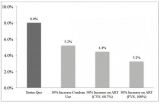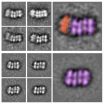(Press-News.org) PROVIDENCE, R.I. [Brown University] — To address the HIV epidemic in Mexico is to address it among men who have sex with men (MSM), because they account for a large percentage of the country's new infections, says Omar Galárraga, assistant professor of health services policy and practice in the Brown University School of Public Health.
A major source of the new infections is Mexico City's male-to-male sex trade, Galárraga has found. In his research, including detailed interviews and testing with hundreds of male sex workers on the city's streets and in its clinics, his team estimates that the prevalence of the virus among them could be as high as 40 percent. Because of inconsistent condom use and high degrees of infection among many sex workers, about 8 percent of their customers and other partners become infected each year. Infection can spread further from there.
But out of such seemingly bleak knowledge, Galárraga said, there is also hope. In a new study in AIDS and Behavior, Galárraga, lead author João Filipe G. Monteiro, and colleagues project that a 10-percent increase in condom use by HIV-positive male sex workers would reduce an 8 percent annual infection rate among their partners to 5.2 percent. Meanwhile, increasing the number of HIV-positive sex workers on antiretroviral medications by 50 percent would slash the infection rate among clients to 4.4 percent. More aggressive interventions could cut the rates further.
"There is universal access to HIV treatment in Mexico, so if this is implemented, especially among these key populations, it can really make a dent in the concentrated epidemic that Mexico has," Galárraga said.
Mexico's male sex trade
Making a big dent — and eventually bringing HIV infection rates down to zero — is the goal of Galárraga's ongoing work in Mexico City, performed in conjunction with local authorities and colleagues there. For years he has been studying the epidemic in the city's MSM community to determine how behavior and biology contribute to the virus' spread and to determine how to intervene.
For the projections in the AIDS and Behavior study, he and his colleagues included data from screenings and interviews with 79 HIV-positive male sex workers 18 to 25 years old. (By now his team has gathered data from a total of 500 workers and counting).
Galárraga, Monteiro, and the team learned that in the week before their research interviews and testing, the 79 infected sex workers reported having 405 unique partners. They used condoms during sex in about three of every four of those encounters. Of the group, only 40 percent were receiving medication and a majority (about 53 percent) had a viral load above 10,000 copies of the virus per milliliter of blood, a threshold far above what's presumed to make someone contagious.
In essence, then, the male sex trade in Mexico City presents a serious infection risk because many sex acts occur without condom use and with sex workers in whom HIV has not been adequately suppressed with medication.
Running the numbers
Using data gathered from the 79 workers and other published data, including estimates of infectiousness given different viral loads, Monteiro, a postdoctoral researcher, built a statistical model to forecast how effective different interventions — increased condom use or increased antiretroviral therapy — might be.
He ran the model 1,000 times each for various assumptions. He found that under the status quo of the epidemic, he was able to estimate the figure that on average 8 percent of partners of male sex workers were becoming infected each year (even accounting for the fact that about 20 percent of the partners were likely already infected to begin with). Increasing condom use by just 10 percent (i.e., from about 75 percent of the time to 82.5 percent of the time) reduced that rate to 5.2 percent. To reduce the infection rate by half (to 4.1 percent) would require increasing condom use by 20 percent (i.e., to 90 percent of the time), the models showed.
For increasing HIV treatment, Monteiro ran the models with two different assumptions: either that the viral suppression rate would be only 60 percent (a real-world level in the sex worker population) or the ideal of 100 percent.
With 60 percent viral suppression, getting 51 percent of sex workers into treatment (a 25-percent increase from the current number), the partner infection rate dropped to 5 percent. With 61 percent on such treatment, the rate dropped to 4.4 percent. If every sex worker were on treatment with 60 percent viral suppression, the infection rate among their partners would decline to 2.5 percent, Monteiro found.
Making interventions work
Galárraga and his collaborators have shared their research findings along the way with Mexico City officials who have taken action to help. To keep HIV-positive people linked to care, for example, the city passed a law providing free bus service for HIV-positive people so that they can more easily get back and forth to clinics.
Galárraga is also working with colleagues to counteract the economic incentive that sex workers have to forgo condoms. Customers offer sex workers more money for condomless sex. Galárraga's research has determined what amount of conditional cash payments could be enough to convince sex workers to turn down that premium.
He has been able to use that data to help Mexican public health officials pilot a payments intervention program in hopes of making condom use more common.
"We know that the market inducements are against prevention," Galárraga said. "So we think it's in the best interests of public health to incentivize key populations to increase ART and to try to use condoms consistently."
INFORMATION:
In addition to Galárraga and Monteiro, other authors include Brandon Marshall, Daniel Escudero, Dr. Timothy Flanigan, Don Operario, and Mark Lurie of Brown; Sandra G. Sosa-Rubí of the National Institute of Public Health (INSP) in Mexico; Andrea González of Clínica Especializada Condesa in Mexico City; and Dr. Kenneth Mayer of the Fenway Institute.
The U.S. National Institutes of Health (grants R21HD065525, T-32DA013911, P30AI042853), The Mexican National Center for HIV/AIDS Control and Prevention (CENSIDA), and Brown University supported the research.
Study models ways to cut Mexico's HIV rates
2014-10-15
ELSE PRESS RELEASES FROM THIS DATE:
Product placement can curb TV commercial audience loss by more than 10 percent: INFORMS study
2014-10-15
Coordinating product placement with advertising in the same television program can reduce audience loss over commercial breaks by 10%, according to a new study in the Articles in Advance section of Marketing Science, a journal of the Institute for Operations Research and the Management Sciences (INFORMS).
Synergy or Interference: The Effect of Product Placement on Commercial Break Audience Decline is by David A. Schweidel, Associate Professor of Marketing at Goizueta Business School, Emory University, Natasha Zhang Foutz, Assistant Professor of Marketing at McIntire School ...
Key moment mapped in assembly of DNA-splitting molecular machine
2014-10-15
UPTON, NY—The proteins that drive DNA replication—the force behind cellular growth and reproduction—are some of the most complex machines on Earth. The multistep replication process involves hundreds of atomic-scale moving parts that rapidly interact and transform. Mapping that dense molecular machinery is one of the most promising and challenging frontiers in medicine and biology.
Now, scientists have pinpointed crucial steps in the beginning of the replication process, including surprising structural details about the enzyme that "unzips" and splits ...
ORNL research reveals unique capabilities of 3-D printing
2014-10-15
OAK RIDGE, Tenn., Oct. 15, 2014—Researchers at the Department of Energy's Oak Ridge National Laboratory have demonstrated an additive manufacturing method to control the structure and properties of metal components with precision unmatched by conventional manufacturing processes.
Ryan Dehoff, staff scientist and metal additive manufacturing lead at the Department of Energy's Manufacturing Demonstration Facility at ORNL, presented the research this week in an invited presentation at the Materials Science & Technology 2014 conference in Pittsburgh.
"We can now ...
Transforming safety net practices into patient-centered medical homes -- progress report
2014-10-15
October 15, 2014 – A recently concluded demonstration project made meaningful progress toward introducing a "patient-centered medical home" approach at "safety net" practices serving vulnerable and underserved populations. Lessons learned in the course of developing and implementing the Safety Net Medical Home Initiative (SNMHI) are featured in a special November supplement to Medical Care. The journal is published by Lippincott Williams & Wilkins, a part of Wolters Kluwer Health.
The supplement presents nine original papers sharing "experience and learning" from ...
Bullies in the workplace
2014-10-15
AMES, Iowa – The stories are shocking and heartbreaking, but they are often disjointed and hard to follow. In severe cases, the narratives are even more chaotic. This is reality for victims of workplace bullying and a major reason why they stay silent, said Stacy Tye-Williams, an assistant professor of communications studies and English at Iowa State University.
No one expects to go to work and feel as though they are back on the school playground, but bullying is all too common for many workers. Approximately 54 million workers, or 35 percent of U.S. employees, ...
Sharks that hide in coral reefs may be safe from acidifying oceans
2014-10-15
A study published online today in the journal Conservation Physiology has shown that the epaulette shark (Hemiscyllium ocellatum) displays physiological tolerance to elevated carbon dioxide (CO2) in its environment after being exposed to CO2 levels equivalent to those that are predicted for their natural habitats in the near future.
Atmospheric CO2 levels have increased by almost 40% in the last 250 years, and the world's oceans have absorbed more than 30% of the additional CO2. The resulting rise in seawater CO2 and associated reduction in pH – known as ocean ...
Sheltering habits help sharks cope with acid oceans
2014-10-15
A shark's habitat can reduce its sensitivity to rising CO2 levels, according to Australian scientists.
Globally, ocean acidification - linked to emissions of greenhouse gases - remains a major concern and scientists say it will harm many marine species over the next century.
Researchers from the ARC Centre of Excellence for Coral Reef Studies (Coral CoE) at James Cook University have found that the epaulette shark, a species that shelters within reefs and copes with low oxygen levels, is able to tolerate increased carbon dioxide in the water without any obvious physical ...
Subsidies help breast cancer patients adhere to hormone therapy
2014-10-15
A federal prescription-subsidy program for low-income women on Medicare significantly improved their adherence to hormone therapy to prevent the recurrence of breast cancer after surgery.
"Our findings suggest that out-of-pocket costs are a significant barrier" to women complying with hormone therapy, said Dr. Alana Biggers, assistant professor of clinical medicine at the University of Illinois at Chicago College of Medicine, and lead investigator on the study. Programs that lower these costs can "improve adherence -- and, hopefully, breast cancer outcomes -- for low-income ...
Dolphin 'breathalyzer' could help diagnose animal and ocean health
2014-10-15
Alcohol consumption isn't the only thing a breath analysis can reveal. Scientists have been studying its possible use for diagnosing a wide range of conditions in humans — and now in the beloved bottlenose dolphin. In a report in the ACS journal Analytical Chemistry, one team describes a new instrument that can analyze the metabolites in breath from dolphins, which have been dying in alarming numbers along the Atlantic coast this year.
Cristina E. Davis and colleagues note that studying dolphins' health is about more than preserving their populations — the ...
Discarded cigarette ashes could go to good use -- removing arsenic from water
2014-10-15
Arsenic, a well-known poison, can be taken out of drinking water using sophisticated treatment methods. But in places that lack the equipment or technical know-how required to remove it, it still laces drinking water and makes people sick. To tackle this problem, scientists have come up with a new low-cost, simple way to remove arsenic using leftovers from another known health threat — cigarettes. They report their method in ACS' journal Industrial & Engineering Chemistry Research.
Jiaxing Li and colleagues explain that naturally occurring and industry-related arsenic ...






